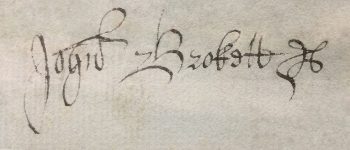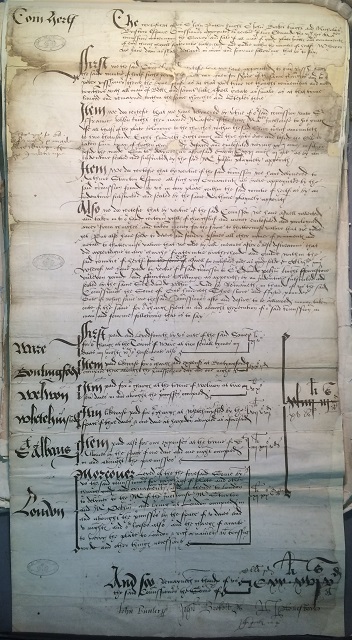Sir John Brokett I of Brockett Hall
b 1511-4 d 1558
You have probably seen images of the grand alabaster altar tomb of Sir John and Dame Margaret in Wheathampstead parish church—some details are below. Meanwhile, here is John’s signature restored from an expenses claim he submitted during the reign of Edward VI (1547-53):1
Would he have signed with a quill or a reed pen?Read more
Contents of this page:
- Expenses claim
- Birth
- Coros’ biography
- Wife Margaret Bensted
- Children
- Other records
- Will and IPM
- Memorial
Expenses claim
Sir John Broket was commissioned by Edward VI (reigned 1547-53) with Sir John Buttler and Nicholas Bristow Esq to assess the goods, plate, jewels and ornaments of every church, chapel, fraternity, brotherhood and guild in Hertfordshire. It took them 17 days and they submitted their findings as a certificate followed by a claim for their expenses as follows:5
Buntingford 1 day 1 night £3 10s 2d
Welwyn 2 days £5 10s
Wheathampstead 4 days £7 5s 7d
St Albans 1 day 1 night £4 13s 5d
London 5 days 5 nights + carriage £11 19s 5½d
Total: £44 3s 7½d
Perhaps there were no expenses for any nights in Wheathampstead as they all stayed at Brockett Hall. The other two commissioners, John Buttler and Nicholas Bristow had other associations with the Brokets: for instance Sir John Buttler as fellow MP in Oct 1553, and Nicholas Bristow Gentleman as a fellow speculator in 1543.
For an image of the whole expenses claim6 click here.
Following is a transcription of the certificate, laid out in the original format: Read more
Birth
Son of John Broket of Swaffham Bulbeck, the exact year of John’s birth is not known. In his grandfather’s IPMs he—the heir—was said to have been ‘aged 21 and more’ on 6 Sep 1532.7 This would date his birth by 5 Sep 1511. Later as a witness to a case re Walter Horley he was said to be aged 33 on 30 Jan 1547.8 This would date his birth 1513 or Jan 1514. John was a member of the Middle Temple in 1552, and Baker suggested an admission c 1535 aged 21, based on a birth c 1513/14.9
On his father’s death in 1526 John was about 14 and probably remained at Swaffham Bulbeck until he inherited the Wheathampstead estates on his grandfather’s death 6 years later. Of John’s 3 dynastic contemporaries, his uncle Edward of Letchworth was the next senior householder in the dynasty, then William I of Hitchin and John of Offley.
Coros’ biography
BROCKET, John (1513/14-58), of Wheathampstead and Brocket Hall, Hatfield, Herts.10
Comments on Coros’ biography
Overall it is a reliable summary of Sir John I’s life. Four points:
- John was probably brought up with his parents and siblings in Swaffham Bulbeck rather than Wheathampstead. His grandfather built Brockett Hall in the parish of Hatfield, where John would have moved to on his death in 1532. Nonetheless, he was buried in the ancestral parish of Wheathampstead, rather than Hatfield.
- 22 Feb 1546/7 is the date given by Shaw18 when John Brokett was dubbed Knight of the Carpet by the King.
- Yes, the Brockets were old-established—they had been in the county since the 1420s—but numerous, no. During John’s adulthood there were only 4 Broket families in Hertfordshire, including his own.
- John may not have gone to an Inn of Court, but he appears to have gone to Cambridge, recorded—without a first name—as B A 1526-7.
Wife Margaret Bensted
John married Margaret BENSTED. As the heir and future head of the dynasty, John’s marriage must have been politically, economically and socially strategic, yet it is difficult to be fully sure of Margaret’s parents or what the full extent of her inheritance might have been. The Hertfordshire Bensted Wills and IPMs need research. The inscription on John and Margaret’s tomb described her simply as ‘dowghter an ayre of Willm Benstede’, and the undifferentiated Bensted arms quarter the shields of their children, see below. Coros’ biography above described her as “da[ughter] and h[eir] of William Bensted of Bennington, Herts”, but while its source for the Bennington connection is sensible, it’s unclear. William Henry Brockett, compiler of the 1860 Gateshead pedigree, added “esquyer” to his transcription, and a ‘d’ to “an”: “dowghter and ayer of Will’m Benstede esquyer”. Again, this is sensible but an unsourced addition. The William Bensted who admitted this John’s father to the Middle Temple in 1509 was in all likelihood Margaret’s father, but the Temple records gave no further information about him.
As to her death, the blanks left on the alabaster tomb for her dates show that she outlived her husband. Unlike Margaret and John’s son John’s 1st wife Helen LYTTON, who held land from the queen in her own right, on which an inquisition was conducted, or his 2nd wife who left a Will as a Widow, no IPM or Will of Margaret as a Widow has been found, and although she was left a life interest in Brockett Hall, her burial was not recorded in the Wheathampstead parish registers. Indeed, after John’s death in 1558, no further record of Margaret has so far been found. Except, that is, a 1588 burial entry in the Dunchurch register, Warwickshire recording “Dame Margarett. Ladye Brocket of Causon was bvried the xxvth of Sept'”:19

This could only have been of our Margaret Bensted, widow of Sir John I. ‘Dame’ was the title for the wife of a baronet or knight,20 and the only such Broket wife with first name Margarett was this Sir John’s. If she had been 18 when she and John had their first child, which was by 1532, then she would have been born by 1514, which is around the time her future husband John was himself born. And if so, dying in 1588 means she would then have been about 74, which was old for those days, but possible. She must have spent her last days—at least—at the home of her daughter Susan Boughton, wife of Edward Boughton of Cawson or Cawston Esq, see Susan below. “Mr Edward Boughton of Cawson Esquyre was buried the xiijth of September” 1589,21 almost a year after Margaret. Susan married again about 18 months later to George Darell.
Children
According to the inscription on the tomb they Sir John and Lady Margaret ‘hade yssue X sonnes and 3 dowghters’. 7 children at least were living in 1557 according to John’s Will, mentioned in the following order:
- John, b by 1532, d 1598 (later Sir John II)
- Edward, b c 1534-40, d 1599 (later Edward of Wheathampstead Place Esq)
- Thomas ‘the elder’, b c 1536-40, married Anne LYTTON 1557-8, but died by 1560.
- Bensted, bap 1548, alive 1557 when his father bequeathed Harpfilde Hall to him (Will line 66) but he probably died young as it became eldest son John’s possession.
- Thomas ‘the younger’. In 1563, or a year or few before, a Thomas Brockett, Gent, was sued by Staple Inn for non-payment of dues as a member, and the proclamation was sent to the sheriff of Herts, as Thomas’ last known place of residence.22 This Thomas was most likely the son of Edward of Broadfield and Letchworth, given that Thomas the younger, son of Sir John, was probably not born before 1549, and that Edward of Broadfield and Letchworth sent his other three sons to Inns of Court. It’s possible that this Thomas, son of Sir John I, was the Thomas working in Hertford in the judicial system in 1590, but he was more likely a Thomas from Edward of Letchworth’s family. Otherwise, what became of this Thomas the younger is not known. He is not known to have had issue.
Of the other 6, apart from a Radulfus or Randoll (1546-1621) the preserved Wheathampstead PR only recorded a William (bap 1544, bur 1545). Randoll apparently had no issue.
Was Robert of Wheathampstead, d 1562, a son?
13-20 years later Glover recorded 6 children: John, Thomas (married Letton and died without issue), Edward, Susan, Elizabeth (married John Pope), Elizabeth without issue. Glover alone recorded 2 Elizabeths.
It seems that only 3 or 4 of John and Margaret’s children had families of their own. Berry23 recorded only 4 children (the order governed by page layout):
- Edward married Ethelred widow of Sir Thomas CHALONER
- Susan married Edward BOUGHTON Esq of Causton, Co Warwick.24 Her great aunt Elizabeth had married into this family.
- Elizabeth married John POPE of Co Oxon
- John married 1. Helen d/o Sir Robert LYTTON; 2. Elizabeth d/o Roger MOORE.
They said they all had issue except Elizabeth. However the Complete Baronetage,25 records that Elizabeth, as John POPE’s 2nd wife, was the mother of his only surviving son and heir William POPE, baptised 15 Oct 1573 in Wroxton, Oxfordshire, created a Baronet of Wilcote, Oxfordshire, on 29 Jun 1611, and made Baron Pope and Earl of Downe on 16 Oct 1628, and died 1631:26
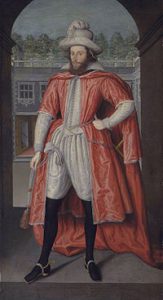
Other records
There are many records; we cite only a few. In the documents of the time the Hall was mostly spelled with two ts: Brockett Hall. The spelling of John’s surname varied.
1530 20 Nov: John Broket junior, his 1st cousin John Barrington Esq [son of his aunt Lady Elizabeth Barrington], Thomas Baryngton senior, and 2 others were recipients of a grant of a tenement with garden in Takeley, Essex:27Read more
Takeley is only 3 m N of Hatfield Broad Oak, where the Barringtons held an estate.
1540-43: With the dissolution of the monasteries Westminster Abbey ceased holding the manor of Wheathampstead in 1540. The new Dean and Chapter of the Abbey let their estates to John in 1543.28
1542: Justice of gaol delivery in St Albans.29
1543 For £728 14s 7½d paid by John Brocket Esquire, John Alwey and Nicholas Bristow Gentlemen were granted:30
- The manor of Holmes aka Canons, Hertfordshire, formerly owned by the dissolved monastery of St Bartholomew in Westsmythfelde, London, worth £4 13s 4d p.a.
- The manor of Ayot St Lawrence, Hertfordshire, formerly owned by Gertrude Courteney, marchioness of Exeter, lately attainted of high treason, worth £27 6s 11½d p.a.
- Robynstown aka Robynstowne in the parish of Sandryge, formerly owned by Gertrude Courteney, worth £3 13s 4d p.a.
- All property in Shenley, Ayot, Sandrige, Codicote, Whethampsted, Wymbley, Wellyn, Radwell, Newneham, Stevenage, Knepworth, Hichyn, Waldon, Lytton, Hatfeld, Kympton and St Albans belonging to these manors.
- The advowson, gift, presentation and free disposition and right of patronage of the parish church of Ayot St Lawrence.
Witness the king, at Terlyng, 24 July 1543.
1544 John Broket esquire brought a plea againstagainst John Brokett late of Ippollitts senior Yeoman, John Brokett late of Ippollitts junior Yeoman, and others, alleging that they forcibly broke into a close of his at Graveley and Ippollitts and cut down and carried off his trees and underwood to the value of 100s.
1578? Letter of attorney to deliver seisin of land in Sandridge parish.31
1545 John was commissioned to be a subsidy assessor for Casio Hundred, which included Brockett Hall.
1546 Thebrydge also called Waterend. John inherited this manor from his grandfather John of Swaffham Bulbeck,32 and according to his own IPM passed it to his son Sir John II.33 It had been in the Fitz Simon family since at least 1303 and had “passed to Elizabeth daughter of Edward Fitz Simon, who married William Ashe, and whose daughter Elizabeth brought it by marriage to Thomas Brockett, who was holding in 1437–8.”34 see the separate page Thomas Broket of Wheathampstead Thebrigge. John’s ownership of this manor was disputed in Chancery in 1546 and he was called to respond to 14 interrogatories,35 of which we only consider his response to the 1st and 9th.
In primis whate landes and tenementes this deponent hathe lieng in the village or Ende called Thebrydge within the feldes and parishe of Sandryge in the county of hertf’
…
Item whether this deponent haith all his landes and tenementes in Thebrydge aforesaid by one tythe or by dyuerse
His deposition began:36 “John Brokett of Whethampsted in the county of hertf’ esquyer sworne and examyned the xxth’ day of May in the xxxviijth’ yere of the reigne of our Souereigne lorde king’ Henry the eight / sayeth and deposethe vpon the said articles as folowithe /
To the first article this deponent saithe that he hathe a mano’r called the mano’r of Thebrydge in the parishe of Sandrydge in the County of Hertf’ whiche he and his auncestours whose estate he hathe haue had and enjoyed by the space of CC yeres and more /”:
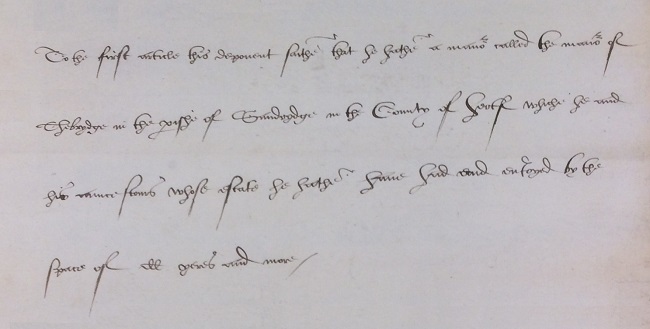
John backed this up by stating that the manor had come to him by a lineal—i.e. direct—descent:37
“To the ixth article this deponent saieth that he hathe all the said mano’r of Thebrydge by dyscent lynyally from his auncestours“.

That it had been his lineal ancestors’ for 200 years was nearly double the actual period, moreover Thomas Broket had acquired it through his marriage to Elizabeth Ashe by 1432, and Thomas and Elizabeth were not John’s lineal ancestors. Here is a close-up of the mis- or dis-information:

It was for false claims like this that Edward of Wheathampstead (d 1488) was portrayed as the son of Thomas and Elizabeth Ash rather than Thomas’ younger brother. Sir John I descended from Edward not Thomas.
1555: John purchased the manor of Westingtons from Sir Nicholas Throckmorton, as mentioned by Coros above. Part of the parish of Ayot St Peter (c 1 m E of Wheathampstead) was in the manor of Westingtons.38 “Ayot Place, now a farm-house, was probably built by Sir George Perient, lord of the manor … On a frieze in the hall are five shields bearing the arms of Perient, Brockett and Boteler quartering Kilpee and the date 1615 in the middle.”39 Westingtons is mentioned in John’s IPM and his son’s in 1599.
1555-58: During Nicholas Heath’s Chancellorship Nov 1555 – Nov 1558, Sir John Brockett submitted a Complaint to Chancery against William Hamond Gent regarding unpaid rent on a tenement belonging to the manor of Brockett Hall alias Appylton Hall, Yorkshire. It seems that Hamond had got hold of the deeds for a tenement and wasn’t paying the 2s 6d rent, and Sir John didn’t know whether the rent was service or sack/seck/dry rent—rent without a power of distress. If it was service rent then he could distrain, but if rent sack he would have to sue at the common law. The Complaint reads:40Read more
A Chancery decree dated 30 Jun 1557 shows that the case had not been resolved by then:John Brockett knight pl William Hamond def
forasmoche as this court is reliablie informed that the defendant is dwelling in the countie of York and commaunded to be ina contynuall redynes to serve the king & quenes ma[jes]ties /. It is therfore ordered that acommission be directed to Wa.. Skargyll and John Ellis gent, to take thanswer of the defendant or not. Michaelmas.42
The excuse of not coming to court in person in order be in continual readiness to serve the King and Queen suggests a role in the maintenance of law and order in Yorkshire, however there is no mention of any particular disorders in Yorkshire in the printed Acts of the Privy Council for 1557, nor of William Hamond.43
Since Sir John died 23 Mar 1557/8, Hamond probably got away with it. Sir John’s Will doesn’t mention property in Yorkshire, and an IPM for his Yorkshire land hasn’t been found—it probably wasn’t held in chief.
Will and IPM
Written 14 Aug 1557, proved 3 May 1558. Sir John died 23 Mar 1558.44 Executors: wife Margaret and 2nd son Edward [of Wheathampstead]. Transliteration is from two copies at the TNA in Kew.45 The British Library also has a fine copy with a large oval seal c 9×6 cm.46
John gave Margaret: Brokett Hall with all its lands, buildings etc and all his copyhold lands in Hatfield and Waterend Farm ‘for terme of hir Lief and so Longe as she keapeth hir self sole and vnmaried’ (lines 40-6) and if she remarried, she was still to receive £50 p.a. (lines 52-3).
There would have been a large gathering at the funeral. His will (lines 13-5) says, ‘I will that myne Executoures give to euery preist that shalbe at my buriall xijd and to euery Clarcke beinge above the age of xvj iiijd and to euery other clerc ijd and to euery poore man woman and childe jd to praye for my sowle.’ John died during Philip and Mary’s reign.
Among the bequests to his children was to:
Thomas the elder, referring to his marriage to Anne Lytton (lines 56-64): “all my landes tenementes and hereditamentes with their appurtenaunces lieng in the Countie of Nottinghame”
1558: In the Michaelmas term of 155847 at the court of Common Pleas at Westminster Margaret Brokett widow and Edward Brokett executors of the testament of John Brokett knight tried to recover an alleged debt of £10 from John Robyns late of Pullockes Hyll in Bedfordshire Yeoman:48Read more
IPM. Chancery and Exchequer copies of John’s IPM survive. The former is very large and the latter is in a bad state and largely illegible.49
Memorial
In his Will (lines 9-13) John said, “I bequeathe … my bodie to be buried in the parishe churche of whetamsted in the Chappell whereas my Auncestours be buried and I will that an honest Tombe there be made for the remembraunce by the Discreacion of myne Executours.” Originally an altar tomb in the Brocket Chapel, it has since been moved through 90 degrees. For some excellent images and comment see Bob Speel’s website.50 The VCH 51 described it as:
There are 8 small figures on the sides of the tomb, 3 males and 3 females each on the long sides, and 2 males on the visible short side. There may be another 2 on the hidden short side, which would make 10 in all, symmetrically representing their large family, which on the inscription around the tomb said comprised 10 sons and 3 daughters. The 8 small figures all stand holding a heraldic shield. “The two on the short side are miniature versions of the statue of Sir John, with the same style of armour, two chains round the neck, and a long sword by the side. On the south side, that is to the side of Sir John above, are three more standing men, robed rather than with armour, two together, one apart, really rather damaged. To Dame Margaret’s side, northwards, are three more statuettes, this time female and dressed rather like [Dame Margaret], with the same open outer garment and puffed sleeves, and in a better state of preservation than the other small figures – one is shown [below]. They wear some sort of headgear, or tightly curled locks, and this may be what Dame Margaret originally had on her head”:52
The Bensted arms—gules three bars gemelles, or—can be seen quartering Broket on the shield of the daughter below, although the colours have faded:
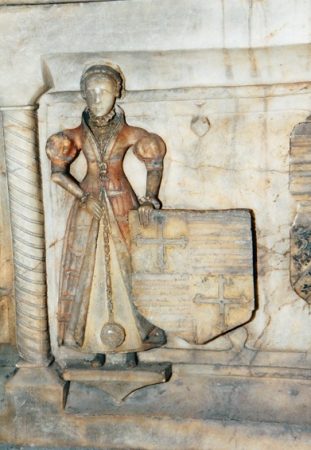
This quartering indicates that they were Dame Margaret’s arms.
William Henry Brockett, compiler of the 1860 Gateshead pedigree, studied the tomb—and heraldry—carefully: Read more
Thus these families were recorded on the tomb: Brocket; Bensted; Lytton; Booth; Neville; Fauconberg; Harwood.
Page Last Updated: May 25, 2023
[1] TNA E117/14/193. Reproduced by kind permission of the National Archives licensed under the Open Government Licence v3.0, and restored by Janet Rogers June 2018 using the programs Picasa and Photo Gallery.
[2] Communication from David Bethell June 2018.
[3] Communication from David Bethell June 2018.
[4] Communication from David Bethell June 2018.
[5] TNA E117/14/193 date unknown.
[6] TNA E117/14/193. Reproduced by kind permission of the National Archives licensed under the Open Government Licence v3.0.
[7] TNA C142/53/29 and E150/233A/15.
[8] TNA C24/230.
[9] Baker 2012 p 366, under John II, citing the same source as Coros (TNA C142/53/29). Baker 2012 p 54 fn 34 re age. In other aspects Baker understandably confused this John with his father John and grandfather John.
[10] Bindoff 1982 pp 499-500, Reproduced by permission of the Trustees of the History of Parliament. Three internal links have been added; otherwise the text is as Bindoff published, including footnotes. The online version is at goo.gl/gv7kND (accessed 21 Aug 2018). The History of Parliament's Communications and Outreach Officer Dr Emma Peplow could not find anything out about D F Coros, and believed the name was Corcos (Email correspondence Feb 2017).
[11] Coros' footnote 1: Only the surname remains on a damaged return, C219/18B/37.
[12] Coros' footnote 2: Aged 33 in January 1547, C24/23, but said to be of age at gd.-fa.'s death, C142/53/29. Trans. E. Herts. Arch. Soc. vii. 402; Clutterbuck, Herts. i. 522; Lit. Rems. Edw. VI, p. cccii.
[13] Coros' footnote 3: LP Hen. VIII. xv. xvi, xxi; CPR, 1550-3, p.394; 1553, pp.354,414; 1553-4, p.20.
[14] Coros' footnote 4: Trans. E. Herts. Arch. Soc. vii. 402; Chauncey, Herts. i. 32; M.T.Recs i. 27, 62; Black Bk. L. Inn, i.188, 198; C142/53/29; PCC 20 Thower.
[15] Coros' footnote 5: LP Hen. VIII, xiv, xviii, xix; CPR, 1553-4, p. 380; 1554-5, p. 13; C1/947/47-49;Herts. Gen. and Antiq. ii. 28.
[16] Coros' footnote 6: C142/53/29; CPR, 1553-4, p. 421; 1554-5, p. 42; Clutterbuck, i. 522.
[17] Coros' footnote 7: PCC 18 Noodes; C142/116/83. D.F.C.
[18] 1906 vol 2 pp 59-60.
[19] Image snipped and cleaned from FamilySearch ark:/61903/1:1:VHXH-R2R, accessed 7 May 2023, item 2 right page (p 35), courtesy of Warwick County Record Office.
[20] Laslett 1983, p 38.
[21] Image accessed at FamilySearch ark:/61903/1:1:VHXH-RPH, 7 May 2023.
[22] Baker 2012 pp 55, 142.
[23] and Clutterbuck after him.
[24] The 1860 pedigree adds 'or Broughton'.
[25] p 52 (creations by James I) goo.gl/eXDHZ4 (accessed 21 Aug 2018).
[26] Painting by Robert Peake goo.gl/SFvrts (accessed 21 Aug 2018), in the public domain.
[27] ERO D/DBa T4/252.
[28] Munby 1974 p 50.
[29] Baker 2012 p 366, citing Letters and Papers of Henry VIII xvi 580(8) available through British History Online.
[30] BL Add Ch 66705.
[31] BL Add Ch 35513.
[32] His IPM of 1532.
[33] VCH Herts vol 2 p 434 note 38 ('Parishes: Sandridge', in A History of the County of Hertford: Volume 2, ed. William Page (London, 1908), pp. 432-438. British History Online (accessed 7 May 2023).
[34] Ibid., notes 30, and 32.
[35] TNA E321/37/12 pp 185ff.
[36] TNA E321/37/12 p 189, image reproduced by kind permission of the National Archives licensed under the Open Government Licence v3.0; VCH Herts vol 2 p 434 n 37.
[37] TNA E321/37/12, p 190, image reproduced by kind permission of the National Archives licensed under the Open Government Licence v3.0.
[38] 'Parishes: Ayot St. Peter', in A History of the County of Hertford: Volume 3, ed. William Page (London, 1912), pp. 63-65. British History Online at goo.gl/3XA3o3 (accessed 1 Sep 2018), citing Pat. 1 & 2 Phil. and Mary, pt. i; Feet of F. Herts. East. 1 & 2 Phil. and Mary; Add. Chart. 35327–35330 accessed 7 November 2016.
[39] 'Ayot St. Peter', in An Inventory of the Historical Monuments in Hertfordshire (London, 1910), p. 44. British History Online at goo.gl/WeHLKe (accessed 1 Sep 2018).
[40] TNA C 1/1404 pieces 69 and 70. The two pieces are identical except for the spelling of various words, with one exception. The title of piece 69 has 'To the moste reuerend Father in god Nicholas Archebysshoppe of Yorke and Lorde Chauncellour of England' whereas piece 70 has 'To the Righte Reuerende father...'. An archbishop should be 'most reverend', a mere bishop 'right reverend'. It was as well to be punctilious about these things (communication from David Bethell 18 Aug 2019). Perhaps they rewrote the Complaint for that reason. Piece 69 is torn at the top left corner and missing words have been filled in from piece 70.
[41] The TNA catalogue mistakenly has Lenton.
[42] TNA C33/15 f 281v, available on AALT (accessed 18 Aug 2019). Thanks to David Bethell for this reference.
[43] Communication from David Bethell 17 Aug 2019.
[44] Inscription on his tomb.
[45] PROB 11/40/f18 and PROB 10/34/Doris.sp/2202703.
[46] BL ms Add Ch 28953.
[47] 5 & 6 Philip & Mary.
[48] TNA CP40/1176 m.401 (f0822, d0695). For the original Latin please contact the Broket Archivist.
[49] TNA C142/116/83, TNA E150/331/14.
[50] goo.gl/oX6Xzx (accessed 1 Sep 2018).
[51] Herts vol 2 p 311, goo.gl/BywDQJ (accessed 21 Aug 2018).
[52] goo.gl/oX6Xzx (accessed 1 Sep 2018).
[53] According to the rules of cadency, a mullet, a five pointed star represented a third son, as William Neville Earl of Kent had, although with a mullet gules (Moncrieffe & Pottinger 1953 p 20).


